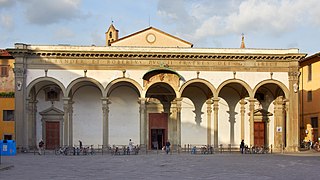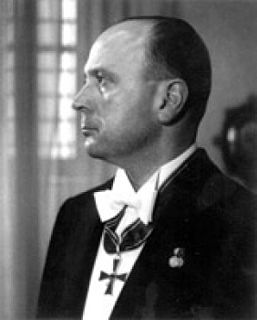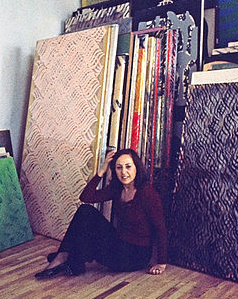
The Basilica della Santissima Annunziata is a Renaissance-style, Roman Catholic minor basilica in Florence, region of Tuscany, Italy. This is considered the mother church of the Servite Order. It is located at the northeastern side of the Piazza Santissima Annunziata near the city center.

The Accademia di Belle Arti di Firenze is an instructional art academy in Florence, in Tuscany, in central Italy.

The Galleria dell'Accademia di Firenze, or "Gallery of the Academy of Florence", is an art museum in Florence, Italy. It is best known as the home of Michelangelo's sculpture David. It also has other sculptures by Michelangelo and a large collection of paintings by Florentine artists, mostly from the period 1300–1600, the Trecento to the Late Renaissance. It is smaller and more specialized than the Uffizi, the main art museum in Florence. It adjoins the Accademia di Belle Arti or academy of fine arts of Florence, but despite the name has no other connection with it.

The Accademia di Belle Arti di Bologna is a public tertiary academy of fine art in Bologna, in Emilia-Romagna in northern Italy. It has a campus in Cesena.

Giuliano Vangi is an Italian sculptor. He received the Praemium Imperiale prize, category sculpture, in 2002, considered the Nobel Prize of Arts.

The Accademia delle Arti del Disegno, or "Academy of the Arts of Drawing", is an academy of artists in Florence, Italy. The Accademia e Compagnia delle Arti del Disegno, or "academy and company of the arts of drawing", was founded on 13 January 1563 by Cosimo I de' Medici, under the influence of Giorgio Vasari. It was made up of two parts: the Company was a kind of guild for all working artists, while the Academy was for more eminent artistic personalities of Cosimo’s court, and supervised artistic production in Tuscany. It was later called the Accademia delle Arti del Disegno.
Louis Alexander Waldman is an American art historian and author specializing in the Italian Renaissance.

Rodolfo Siviero was an Italian secret agent, art historian and intellectual, most notable for his important work in recovering artworks stolen from Italy during the Second World War as part of the 'Nazi plunder'.

Carla Accardi was an Italian abstract painter associated with the Arte Informel and Arte Povera movements, and a founding member of the Italian art groups Forma (1947) and Continuità (1961).
Alessandro Vezzosi is an Italian art critic, Leonardo scholar, artist, expert on interdisciplinary studies and creative museology, he is also the author of hundreds of exhibits, publications and conferences, in Italy and abroad on Leonardo da Vinci and the Renaissance, contemporary art and design. Amongst others, he was the first scholar from the Armand Hammer Centre for Leonardo Studies from the University of California in Los Angeles (1981), directed by Carlo Pedretti; he taught at the University of Progetto in Reggio Emilia; and he is honorary professor at the Accademia delle Arti del Disegno of Florence. He began as an artist from 1964 to 1971 winning more than 80 prizes in painting competitions. In the Seventies he was the founder of the “Archivio Leonardisimi” and of Strumenti-Memoria del Territorio; he coordinated "ArteCronaca", he was the historical-artistic consultant of the Municipality of Vinci and he collaborated on the publications on Tuscany and Leonardo, modern and contemporary art. In 1980 he curated the Centro di Documentazione Arti Visive of the Municipality of Florence.
Accademia Fiorentina or Florentine Academy may refer to:
Academy of Florence or Accademia di Firenze may refer to:

The Palazzo dell'Arte dei Beccai or Residenza dell'Arte dei Beccai is a fourteenth-century building in Florence, Italy. It faces the Orsanmichele, once a grain market, later the church of the guilds of Florence. It has had many occupants, including the Arte dei Beccai or guild of butchers from which its name derives. Since 1974 it has housed the Accademia Fiorentina delle Arti del Disegno, an academy of the arts.
Accademia often refers to:

The Accademia di Belle Arti di Perugia is a private tertiary academy of art in Perugia, in Umbria in central Italy. It is not one of the 20 official Italian state academies of fine art, but is legally recognised by the Ministero dell'Istruzione, dell'Università e della Ricerca, the Italian ministry of education and research, which gives its full name as Accademia di Belle Arti Legalmente Riconosciuta di Perugia "Pietro Vannucci". The academy became an autonomous degree-awarding institution under law no. 508 dated 21 December 1999.

Domenico di Zanobi, also Master of the Johnson Nativity, was an Italian painter. His exact dates of birth and death or not known.
Ugo Capocchini was an Italian artist. He won many awards throughout his career, and became a Professor at the Accademia Di Belle Arti in Florence in the 1960s. In his birthplace, Barberino Val d'Elsa, a square and a community hall have been named after him.
Andrey Kimovich Esionov is a Russian painter and graphic artist, who paints portraits and cityscapes. He is academician of the Russian Academy of Arts, Honorary Academician of the Florentine Academy of Fine Arts and Drawing, a member of the Russian Artistic Union of Painters (1995), the Moscow Artists' Association of International Art Fund, and the Union of Russian Artists.

Francesco Maria Niccolò Gabburri was a Florentine diplomat, painter, art collector, and biographer of artists.
Adolfo Natalini was an Italian architect.











